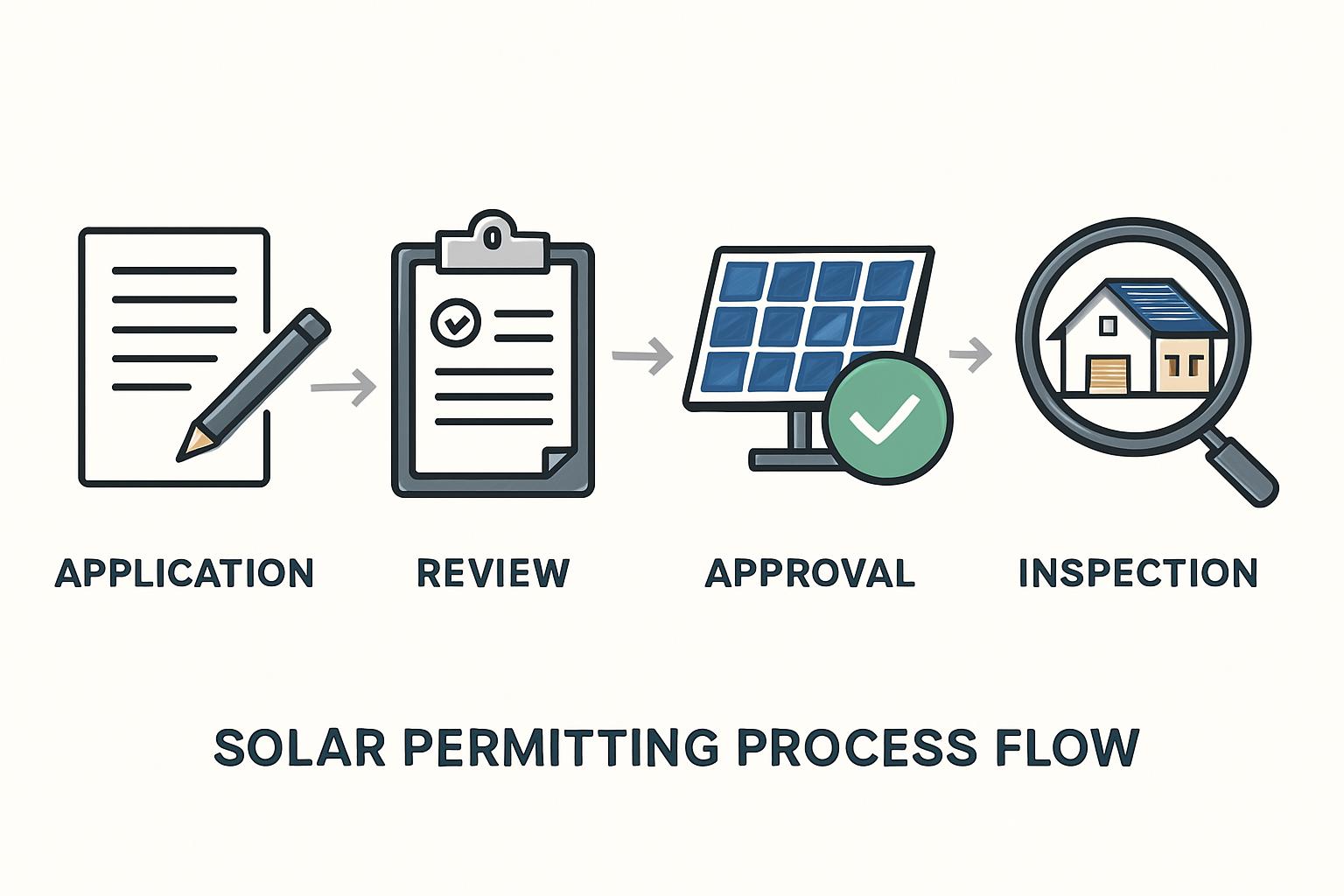Efficient solar installation permits are crucial for accelerating renewable energy adoption. Authority Having Jurisdictions (AHJs) face the ongoing challenge of balancing rigorous safety standards with the need for streamlined approval processes. SolarAPP+ emerges as a powerful digital tool designed to automate and standardize residential solar and solar-plus-storage permitting. This review examines its compatibility and potential benefits for your AHJ in 2025, helping you determine if it aligns with your operational goals and community needs.

The Promise of Automated Solar Permitting
SolarAPP+ (Solar Automated Permit Processing) offers a standardized, online platform for instant permit approvals. It aims to reduce the time and resources AHJs spend on reviewing routine solar installations. This automation helps both homeowners and installers by providing clear, consistent requirements and rapid feedback.
What is SolarAPP+?
SolarAPP+ is a web-based portal developed by the National Renewable Energy Laboratory (NREL). It performs automated compliance checks against national and local building codes for eligible residential solar photovoltaic (PV) and solar-plus-storage systems. Installers submit project details, and if the system meets all criteria, a permit is issued almost instantly. This significantly cuts down on traditional manual review times, which can often take weeks. The IEA's 'Advancing Clean Technology Manufacturing' report highlights the strong near-term momentum for clean manufacturing, with committed projects through 2025 poised to exceed global solar PV deployment needs by 50% in 2030. This growth underscores the urgent need for efficient permitting solutions.
How it Streamlines the Process
The core benefit of SolarAPP+ is its ability to standardize permit applications. It ensures that all necessary information is provided upfront, reducing back-and-forth communication. The automated checks cover critical aspects like structural integrity, electrical safety, and fire setbacks. This consistency minimizes errors and ensures compliance, freeing up AHJ staff to focus on more complex projects or inspections. For instance, solar PV systems consistently receive the majority of certificates for small-scale technology, indicating their widespread adoption and the need for streamlined processes, as noted in the IEA's 'Medium-Term Renewable Energy Market Report 2016'.
Evaluating SolarAPP+ for Your AHJ in 2025
Adopting SolarAPP+ involves assessing various factors, from technical readiness to policy alignment. Your AHJ's unique context will shape its compatibility with this automated tool.
Technical Requirements and Integration
For SolarAPP+ to function effectively, your AHJ needs a compatible permitting software system. The platform integrates with many existing permit management systems, but some customization or upgrades might be necessary. You will need to ensure your IT infrastructure can support the data exchange and that your staff has access to the necessary hardware and internet connectivity. The system requires accurate local code parameters to be configured, ensuring that the automated checks reflect your specific regulations.
Policy and Regulatory Alignment
Before implementation, your AHJ must formally adopt SolarAPP+. This often involves local legislative action or policy changes to recognize the automated permit as valid. You will need to review your current building codes and ordinances to ensure they align with the standardized requirements of SolarAPP+. Any deviations may require adjustments to the tool's configuration or updates to local codes. Engaging with local stakeholders, including installers and community members, can facilitate a smoother transition.
Addressing Common Concerns
Some AHJs express concerns about loss of local control or the inability to handle unique project circumstances. SolarAPP+ is designed for routine, compliant projects, meaning complex or non-standard installations still require manual review. It acts as a filter, allowing staff to dedicate more time to these intricate cases. Initial training and clear communication with installers about the scope of SolarAPP+ can mitigate these concerns. The goal is to enhance efficiency without compromising safety or local oversight.
Realizing Benefits: Faster Approvals and Broader Impact
Implementing SolarAPP+ offers tangible advantages, from reducing administrative burdens to accelerating the transition to clean energy.
Reduced Administrative Burdens
By automating permit reviews for eligible projects, SolarAPP+ significantly reduces the workload on AHJ staff. This allows building departments to reallocate resources, improving service delivery for all types of permits. For example, if 40% of solar permits can be instantly approved, staff can process other applications more quickly, leading to overall departmental efficiency gains. This operational improvement can also lead to cost savings for the AHJ.
Accelerating Solar and Storage Deployment
Faster permit approvals directly translate to quicker solar and energy storage installations. This benefits homeowners by reducing waiting times and allows installers to complete more projects annually. Our company, with years of experience in the solar and energy storage industry, understands that efficient permitting is a cornerstone of successful project deployment. We focus on providing reliable and scalable energy solutions, including high-performance lithium iron phosphate (LiFePO4) batteries and integrated home energy storage systems, which rely on streamlined approval processes to reach customers efficiently. The IRENA 'Renewable Power Generation Costs in 2024' report underscores the increasing cost-effectiveness of renewable power, making rapid deployment even more attractive.
Enhanced Safety and Compliance
The automated compliance checks within SolarAPP+ ensure that all approved systems meet stringent safety and building codes. This reduces the potential for human error in manual reviews, leading to a higher standard of compliance across the board. Installers are incentivized to adhere to best practices, as non-compliant projects will not receive instant approval. This proactive approach to safety benefits both the property owner and the community.
Preparing for a Digital Permitting Future
The trend towards digital permitting is undeniable. Preparing your AHJ for this shift means strategic planning and continuous adaptation.
Steps for AHJ Adoption
Adopting SolarAPP+ typically involves several key steps:
- Research and Evaluation: Understand the tool's capabilities and how it fits your local context.
- Stakeholder Engagement: Consult with local installers, community leaders, and internal staff.
- Policy and Code Review: Align local ordinances with SolarAPP+ requirements.
- Technical Integration: Work with your IT department to ensure seamless system compatibility.
- Staff Training: Provide comprehensive training for all relevant personnel.
- Pilot Program: Consider a phased rollout to gather feedback and refine processes.
Training and Ongoing Support
Successful implementation of any new technology relies heavily on adequate training and support. SolarAPP+ provides resources for AHJs, including documentation and webinars. Establishing clear internal protocols for using the system and addressing issues is vital. Ongoing support from NREL and the SolarAPP+ community can help resolve challenges as they arise and keep your AHJ updated on new features.
The Role of Energy Storage in Permitting
As more homeowners integrate battery energy storage systems (BESS) with their solar installations, the need for efficient permitting extends to these combined systems. SolarAPP+ supports solar-plus-storage projects, ensuring that the entire system meets safety and electrical codes. This integrated approach is crucial for promoting energy independence and grid resilience. Our expertise in developing integrated ESS, including hybrid inverters and solar panels, emphasizes the importance of a permitting system that can handle these advanced configurations seamlessly.
Embracing Efficiency for Energy Independence
SolarAPP+ represents a significant step forward in modernizing solar installation permits. For AHJs in 2025, evaluating its compatibility is not just about adopting a new tool; it is about embracing efficiency, supporting renewable energy growth, and enhancing public safety. By streamlining the approval process, your AHJ can play a pivotal role in accelerating the transition to a more sustainable energy future, benefiting both your community and the broader energy landscape.
Frequently Asked Questions
What types of solar projects does SolarAPP+ cover?
SolarAPP+ primarily covers residential rooftop solar PV systems and solar-plus-storage installations that meet specific criteria for size, configuration, and compliance with national codes. Complex or non-standard projects typically still require manual review by AHJ staff.
How does SolarAPP+ ensure compliance with local building codes?
AHJs configure SolarAPP+ with their specific local code parameters. The system then performs automated checks against these configured rules, as well as national standards, to ensure that submitted projects meet all necessary requirements before issuing an instant permit.
What are the main benefits for an AHJ adopting SolarAPP+?
The primary benefits include significantly reduced permit review times, decreased administrative burden on staff, enhanced consistency and accuracy in code compliance, and accelerated deployment of solar and energy storage systems within the community. This ultimately contributes to greater energy independence and sustainability.





Leave a comment
All comments are moderated before being published.
This site is protected by hCaptcha and the hCaptcha Privacy Policy and Terms of Service apply.